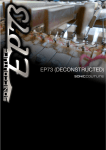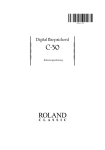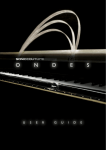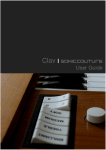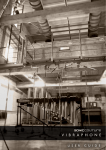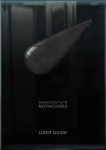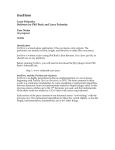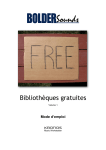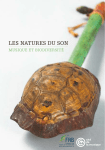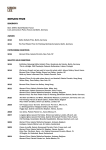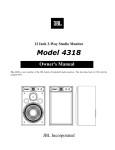Download SC Conservatoire User Guide
Transcript
SONICCOUTURE CONSERVATOIRE COLLECTION USER GUIDE T H E C O N S E R VA T O I R E C O L L E C T I O N USER GUIDE www.soniccouture.com email :[email protected] SONICCOUTURE CONSERVATOIRE COLLECTION USER GUIDE THE CONSERVATOIRE COLLECTION CONTENTS : INSTALLATION ABOUT THE COLLECTION THE INSTRUMENTS THE KONTAKT INSTRUMENTS SUPPORT E.U.L.A www.soniccouture.com email :[email protected] SONICCOUTURE CONSERVATOIRE COLLECTION USER GUIDE INSTALLATION This Library requires Kontakt 4.2.3 or later. If you do not own Kontakt, you will need to download and install the free Kontakt player which you can do here ; Kontakt Player Download Link TO ADD THE LIBRARY AND AUTHORIZE IN KONTAKT 1. In Kontakt or Kontakt Player ( Standalone Mode Only ) open the Browser on the left (the folder Icon at the top). 2. In the Libraries tab at the top of the Browser go to "Add Library" 3. Click and use the dialogue window to navigate to and point Kontakt to the location of the The Conservatoire Collection>Library folder. This will add it to the Kontakt Library list AND to the Service Center. 4. If Kontakt asks you to Activate the library, the NI Service Center program will launch and you will need your serial number to authorize Conservatoire. If Kontakt doesn't ask you to authorize, you can force it to by clicking the little "Activate" button in the upper right corner of our Conservatoire Library logo, in the Browser/Libraries list. It will then prompt you to launch the Service Center. (You will find your serial number in the email you were sent when you purchased. If for some reason you haven't received this yet, you can run your library in demo mode until it arrives.) N.B : After authorization, you should restart Kontakt. www.soniccouture.com email :[email protected] SONICCOUTURE CONSERVATOIRE COLLECTION USER GUIDE ABOUT THE COLLECTION EARLY MUSIC & THE BIRMINGHAM CONSERVATOIRE FOREWORD BY MARTIN PERKINS Martin Perkins is Early Music Lecturer & Instrument Curator at Birmingham Conservatoire and was consultant producer for the Conservatoire Collection project. Birmingham Conservatoire was founded at the end of the nineteenth century and quickly established itself among the country's leading institutions, training generations of young musicians. Soon after its inception, the Conservatoire established a collection of historical musical instruments receiving antique and rare instruments from benefactors and collectors. For much of their life in the Collection, these instruments served the staff and students as mere illustrations of music-making in a forgotten age. But, the www.soniccouture.com email :[email protected] SONICCOUTURE CONSERVATOIRE COLLECTION USER GUIDE middle of the last century witnessed a revolution in music-making in the classical world, as musicians all over Europe quietly plundered the museum cabinets to see for themselves just what these old instruments sounded like. Thus began the movement which has variously been called 'period performance', 'authenticity', 'historically informed' or just plain 'early music'. The pioneers, 60 years ago, who put down their modern instruments in favour of the historical precursors, were laughed at by the classical elite. Yet, once tamed, the sheer beauty of sound from these instruments won the hearts of concert-goers, the conservative musicians and the record-buying public. The historical instrument movement would not have been possible without the many ingenious instrument makers who patched up the old museum exhibits, made copies of the originals and transformed the crumbling relics into living musical instruments. The vast majority of today's period instrument performers play on accurate reproductions of original instruments. This is a necessary compromise in order to preserve the few remaining originals for future generations. With this in mind, The Conservatoire Collection uses historical originals as well as modern reproductions made by the most sought-after luthiers who remain faithful to the original. Today, many Conservatoires around the world train young musicians to play historical instruments and equip them with the knowledge of the style and techniques of the time to be able to bring the music of the great masters alive, as they may have expected their music to sound. Birmingham Conservatoire set up its Early Music Programme in 1991 and has led the field in introducing historical instruments and style to as many young musicians as possible for over 20 years. www.soniccouture.com email :[email protected] SONICCOUTURE CONSERVATOIRE COLLECTION USER GUIDE WORKING WITH REPRODUCTION INSTRUMENTS Most of the instruments in the collection are reproductions ; the originals are simply too old to be played. This is not only because they are priceless artifacts, but also because over time the materials have degenerated to such an extent that they no longer sound very good. The reproduction instruments are generally exact copies of a specific original instrument - materials and manufacturing processes are exactly duplicated according to the period of the original. Through this painstaking manufacturing process, the instrument builder can be sure that the sound is identical to how the original would have sounded in the 16th century. www.soniccouture.com email :[email protected] SONICCOUTURE CONSERVATOIRE COLLECTION USER GUIDE THE INSTRUMENTS KEYBOARDS The modern acoustic piano is an instrument which has slowly developed through the last two hundred years, arriving at the concert grand piano which we see today. Many new inventions - the clavichord, harpsichord, spinet, virginals - as well as the piano’s immediate precursor, the fortepiano, were popular instruments in their day but which were superseded through unsuitability to the changing circumstances of music making. The harpsichord family of keyboard instruments was widely used during the seventeenth and eighteenth centuries and used for all kinds of musicmaking - in church, in the court, or as a home instrument. Indeed, most music written during this time was conceived for performance with a keyboard instrument (or some other chord instrument) accompanying voices and instruments. It is the instrument which gives Baroque music its www.soniccouture.com email :[email protected] SONICCOUTURE CONSERVATOIRE COLLECTION USER GUIDE distinctive characteristic sound and instantly places the listener into that sound-world. Just as a piano might fall into the category of percussion, because hammers strike each string, a harpsichord might be described as a plucked stringed instrument. The sound is produced when a small plectrum, attached to a wooden ‘jack’, plucks each string. The keys of the instrument are simple levers, at the end of which, the jacks rest, and so are pushed up when the player depresses the key. This simple mechanism, or action, relies on the weight of the jack to bring the plectrum back down again, a simple needle spring stops the strings from being plucked when the key is released and a small cloth damper ensures that the sound from the string stops when the key is released. It is thought that the first keyboard instruments using this action were made during the 14th century in Italy. Various sizes and shapes of instrument were constructed during the Renaissance and Baroque periods. 18TH CENTURY FRENCH HARPSICHORD www.soniccouture.com email :[email protected] SONICCOUTURE CONSERVATOIRE COLLECTION USER GUIDE The instrument chosen for our library was a copy of a harpsichord originally made by Paul Taskin in 1762 and later enlarged by Jean Goermanns in 1780. The original instrument is housed in the Edinburgh University Collection of Historical Musical Instruments, and the copy used for the sample library was made by Michael Johnson in 1996. The original instrument is one of the most copied 18th century harpsichords, Michael Johnson’s copy is highly regarded as a faithful reproduction. The instrument has two keyboard manuals and uses three sets of strings: two at normal, ‘8 foot’ pitch (using pitch terminology from the organ world), and one at 4 foot pitch, an octave higher. There is also a ‘buff’ stop on one of the 8 foot sets of strings which, by applying a small pad of soft leather to each string, gives the notes a softer edge, much like a lute. 17TH CENTURY FLEMISH HARPSICHORD www.soniccouture.com email :[email protected] SONICCOUTURE CONSERVATOIRE COLLECTION USER GUIDE The instrument chosen for the collection was a copy of a harpsichord made by Johannes Ruckers, made in 1637. The original, housed in the Edinburgh University Collection of Historical Musical Instruments, has one keyboard manual with two sets of 8 foot pitch strings and a buff stop. The copy used for the sample library was made in 2000 by Michael Johnson. Generally speaking, 17th century harpsichords are smaller, and, significantly, shorter than those of the 18th century. The compass of the instrument was less than later instruments and the bass register less resonant. www.soniccouture.com email :[email protected] SONICCOUTURE CONSERVATOIRE COLLECTION USER GUIDE PLUCKED STRINGS Among the first instruments ever designed, constructed and discussed were those of the plucked strings family: by simply tightening a string between two fixed points to produce a note we get a rudimentary harp or lyre, both of these instruments are mentioned in Classical Greek writings and the Bible. During the Renaissance and Baroque periods, innovation in instrument making techniques gave rise to the lute and guitar families, where strings were placed close to the body of the instrument to use a resonant sound box to amplify the sound, and to enable the player to stop the strings. One of the defining features of plucked stringed instruments of the Renaissance and Baroque period is the use of sets of strings, or courses, much like the 12-string guitar of today. The two strings were sometimes tuned an octave apart giving the instruments a rich, resonant sound when played www.soniccouture.com email :[email protected] SONICCOUTURE CONSERVATOIRE COLLECTION USER GUIDE BAROQUE GUITAR A typical instrument has five courses, of which either four or five were double- strung making a total of nine or ten strings. The strings were of gut. The instrument recorded for the sample library is in the French style. This five- course instrument is a copy of various seventeenth century originals made by Martin Haycock. The stringing of the instrument is unusual: the five courses correspond with the top strings of modern guitars, but they are double-strung apart from the top E. The D course features two strings pitched an octave apart: (E3 B2 G2 D3+2 A2). During the early seventeenth century, the guitar was primarily used as an accompanying instrument, playing for dances or accompanying singers. The main playing technique was strumming (rasgueado in Spanish and battute or battuto in Italian) which took advantage of the doubling stringing to achieve a loud and resonant sound. The chords were usually notated by a system called alfabeto, where capital letters were used to indicate chord positions, very similar to modern guitar tabs. www.soniccouture.com email :[email protected] SONICCOUTURE CONSERVATOIRE COLLECTION USER GUIDE THEORBO This late Renaissance development was the ultimate accompanying instrument of the time - by adding an extension to the neck, thick strings giving low notes were placed alongside the conventional lute meaning a player could play a bass- line and give the rhythm. The bass strings, typically 6, have their own peg-box. This essential design of instrument proved to be long-lasting, and it only fell out of favour with performers and composers when the use of ever larger groups of players meant it was not loud enough. The tuning of the theorbo is characterized by the octave displacement, or reentrant tuning, of the uppermost of the uppermost strings, thus limiting the upper range of the instrument. The courses, unlike those of a Renaissance lute or archlute, were often single, though double-stringing was used too. Typically, theorbos have 14 courses. The instrument used for the sample library is a single-strung, 14 course instrument made by Martin Haycock in 2005, after various seventeenth century Italian originals. www.soniccouture.com email :[email protected] SONICCOUTURE CONSERVATOIRE COLLECTION USER GUIDE ENGLISH THEORBO Although there are no surviving original instruments, there are several descriptions, illustrations and paintings of English theorbos dating from the mid- seventeenth century. The instrument used for the library was made by Klaus Jacobson in 2005. The English theorbo has much in common with the small 12-course lute, from which it developed, but it takes elements of the larger, Italian theorbo, such as the deep body. It has 7 stopped courses, all double- strung, and 6 bass courses, also all double-strung and tuned in octaves. It is tuned in G, with one re-entrant course, (G2, D3, A2, F2, C2, G1, F/E1, D1, C1, B, A, G). The stopped string length is around 80cm, and the basses increase gradually in length to 135cm. It has therefore a smoother transition in sound between the stopped courses and the lower diapason strings, without the change of timbre which characterise the Italian theorbo. www.soniccouture.com email :[email protected] SONICCOUTURE CONSERVATOIRE COLLECTION USER GUIDE PSALTERY The Psaltery is one of the oldest of all musical instruments, mentioned in the Bible and in numerous ancient Greek texts. It is a diatonic instrument, used to play chords or melodies. It is played by plucking the strings with quills, one in each hand. As the notes are not stopped by the player, the long decay time give this instrument an ethereal quality. www.soniccouture.com email :[email protected] SONICCOUTURE CONSERVATOIRE COLLECTION USER GUIDE PERCUSSION NAKERS A naker is a small drum, of Arabic origin, with a metal or wood dome-shaped body and animal skin drum head. Played in pairs, nakers made their way to Europe at the time of the Crusades in the thirteenth century. These were small (and therefore portable) but capable of great dynamic contrast so were used both indoors and for outside music-making. The two drums were not set to a specific pitch (unlike the later typical pair of timpani or kettle drums). The instruments used for the collection were copies of the pair in the Montagu collection. www.soniccouture.com email :[email protected] SONICCOUTURE CONSERVATOIRE COLLECTION USER GUIDE RENAISSANCE SIDE DRUM This is a medium large drum with a long shell and skins at either end held in place by wooden rings. The skins can be tightened and on the lower skin there is a snare mechanism made from two gut strings. 18TH CENTURY TIMPANI The successor to the nakers - primarily an outdoor instrument - was the timpani. Used at first for ceremonial occasions with trumpets, by the 18th century the timpani found a new home in the orchestra. The drums are smaller compared to their modern counterparts, they use calf-skin drum heads, and are tuned to different notes without the aid of pedals. www.soniccouture.com email :[email protected] SONICCOUTURE CONSERVATOIRE COLLECTION USER GUIDE HURDY GURDY A typical hurdy gurdy of the mid-Renaissance era featured three drones strings, two melody strings and a further higher drone string used for rhythm. The strings are of gut. Due to the prominence of the Hurdy Gurdy tradition in France, unbroken for centuries, many instrument and performance terms are taken from the French. The instrument used for the sample library is a copy of a sixteenth century original in the Gemeentemuseum, The Hague, and is typical of those of the late Renaissance. The three drone strings are: • G1 drone (gros bourdon) • C2 drone (petit bourdon) • G2 drone (mouche) The fourth string, the rhythm drone is pitched at C3. This string, known as the trompette, features a buzzing bridge (chien - literally “dog”) which creates a harsh sound when the player increases pressure on the wheel. Traditionally, the player would play turn the wheel to the tempo of the music, using his wrist to effect a rhythm whilst turning the wheel. A small peg set in the instrument’s tailpiece (tyrant), is used to control the sensitivity of the buzzing bridge. The last two strings (chanterelle(s)), are the melody strings, www.soniccouture.com email :[email protected] SONICCOUTURE CONSERVATOIRE COLLECTION USER GUIDE stopped with tangents attached to keys activated by the player’s left hand. This gives the player the ability to play diatonic melodies in C. The nature of the hurdy gurdy is one of an all-in-one melody, harmony and rhythm instrument. Even without the player consciously playing rhythmically, and playing without the melody strings chanterelles or the buzzing trompette drone, there is a natural rhythmic fluctuations with each cycle of the wheel. To give users of the sample library more functionality, we sampled each drone and each combination of drones string separately, both with as little fluctuation of the wheel as possible, and with the player playing ‘normally’ in a tempo of 130 bpm. The drone strings work best when used together, due to the sympathetic resonances produced. www.soniccouture.com email :[email protected] SONICCOUTURE CONSERVATOIRE COLLECTION USER GUIDE THE KONTAKT INSTRUMENTS OVERVIEW In general, all the Conservatoire Collection instruments share the same basic structure : OPTIONS TAB Here you will find instrument specific setup controls - not every instrument will have all the following controls, only those that are relevant. VELOCITY : The main knob allows you to adjust the velocity>volume response if the instrument, you can also adjust the curve to suit your playing style/controller. TUNING : The main knob allows you to adjust the root note of the scale. Below this you can select specific tunings from a drop down menu. www.soniccouture.com email :[email protected] SONICCOUTURE CONSERVATOIRE COLLECTION USER GUIDE HAND POSITION : This features on the plucked string instruments. This allows you to assign a MIDI controller to automate the left HAND POSITION control knob on the instrument tab. KEYSWITCHES : Here you can specify which key activates an articulation switch, if the instrument features any. TRANSPOSE : Transposes the pitch of the instrument up or downwards. INSTRUMENT TAB This Tab contains the main controls for each instrument. On the right hand side of the interface you will find instrument-specific controls, if there are any - in the centre panel you will find general controls which appear on all the instruments. WIDTH : This adjusts the stereo width of the samples - hard left is mono, 12o’clock is the natural stereo of the recording. KEY-OFF : Not available for every instrument, this controls the volume level of the key-release samples. www.soniccouture.com email :[email protected] SONICCOUTURE CONSERVATOIRE COLLECTION USER GUIDE BODY : An EQ control for the low-mid frequencies. BRIGHT : An EQ control for highfrequencies. ROOM : Convolution reverb control. Here you can select a suitable impulse response from the drop down menu. The knob adjusts the send level to the reverb processor. To switch reverb OFF, click the ‘ROOM’ button itself. INSTRUMENT SPECIFIC CONTROLS ATTACK & FRET RELEASE ( English Theorbo, Theorbo) : This gives you control of the overall attack time of the notes, as well as seperate control of the release time of the frets and the diapazon. This enables you to set different release responses if desired. HAND POSITION (Baroque Guitar, Theorbo, English Theorbo) This knob gives you control over where on the fretboard the note will be played. Either 4 or 5 positions, depending on the instrument. In general, a passage played in the higher register would be played in a higher hand position and vice versa. www.soniccouture.com email :[email protected] SONICCOUTURE CONSERVATOIRE COLLECTION USER GUIDE ARTICULATION ( Baroque Timpani ) Here you can select different playing styles for the drums, as well as changing the type of beater used. The Keyswitches can be specified on the options page. Note that all the timpani hits are double 2 octaves apart to facilitate playing with two hands. STRING SETS ( Harpsichords ) These are the switches for the various string sets or “stops” : 18th Century French Harpsichord 4 registers: •lower manual 8’ •upper manual 8’ •4’ •8’ lower manual buff stop 17th Century Flemish Harpsichord 3 registers: •8’ I •8’ II •8’ buff stop www.soniccouture.com email :[email protected] SONICCOUTURE CONSERVATOIRE COLLECTION USER GUIDE THE HURDY GURDY INSTRUMENT Because there are quite few different controls, and because it is perhaps not the most intuitive instrument to translate to a sampled format, this instrument requires it’s own section. The first thing to notice is that nothing happens until you turn the Hurdy Gurdy On with the Play Key (C3 by default). This sets the wheel turning, and any strings that are “on” will sound. You start and stop the instrument with this key. The “Chanterelles” or melody strings are played in the area of the keyboard coloured blue; G3-D5. Note that whenever you release a Chanterelle key, it returns to it’s original open string pitch, and keeps sounding. Playing the notes against the open string is typical in Hurdy Gurdy technique, since the www.soniccouture.com email :[email protected] SONICCOUTURE CONSERVATOIRE COLLECTION USER GUIDE open string is in tune with the drone strings and Hurdy Gurdy’s are diatonic instruments (ie. they play in just one key at a time.) On the right, you can turn on or off any of 6 strings: 3 Drone strings tuned in an open fourth G1, C2, G2 layout, the two Chanterelle strings which are tuned in unison at G3. And the Trompette string which is a higher C or can be “Tuned Up” to D. The knobs to the left of each of these strings sets allow you to fine tune the volume of the string sets. The Buzz Key (coloured green) allows you to trigger the “chien” buzzing bridge noise, which is used for rhythmic accents in Hurdy Gurdy playing. The Buzz Key is velocity sensitive. The other keys are not generally velocity sensitive (since the Hurdy Gurdy itself isn’t), although you can add velocity sensitivity to the Chanterelles if you like on the Options page. By default, the entire instrument is playing with a G-C drone, which makes it fine for certain keys, but difficult to play in other keys. On the Options page you can use the Transpose knob to move the entire instrument up or down in pitch if you want to tune it to other keys. In the middle section of the page you have control over the Key Noise, which is the clatter made by the wooden key mechanism that stops the Chanterelle strings at different notes. There are also knobs for the Stereo Width, Body and Brightness EQ, and the Room reverb. www.soniccouture.com email :[email protected] SONICCOUTURE CONSERVATOIRE COLLECTION USER GUIDE SUPPORT If you have any problems or questions relating to the use of this product, please feel free to contact us. You can either email us at : [email protected] or we have a support forum within the KVR Audio community, which can be found here : Soniccouture Support Forum We will always endeavour to reply to any enquiry within 12 hours, but do bear in mind the differences in time zones, so please be patient! www.soniccouture.com email :[email protected] SONICCOUTURE CONSERVATOIRE COLLECTION USER GUIDE E.U.L.A. END USER LICENSE AGREEMENT PREFACE: This End-User License Agreement ("EULA") is a legal agreement between you and Soniccouture LTD for the Soniccouture product accompanying this EULA, which includes computer software and may include associated media, printed materials, and online or electronic documentation ("Software"). By installing, copying, or using the software, you agree to be bound by the terms of this EULA. If you do not agree to the terms of this EULA, you may not use the software. The software is protected by copyright laws and international copyright treaties, as well as other intellectual property laws and treaties. The software is licensed, not sold. Soniccouture Ltd grants the Owner of a Soniccouture product the right to create finished musical works and performances using the sounds and software that comprise the Soniccouture product. The making of sample libraries in any form, commercial or otherwise, using Soniccouture audio or software (be they single hits, loops, fully mixed audio clips, or scripts) is STRICTLY FORBIDDEN without express written agreement of Soniccouture Ltd, and violations will be prosecuted to the full extent of international and local copyright law. The ownership of all title and copyrights in and to the Software (including but not limited to any images, photographs, animations, video, audio, music, text, and "applets" incorporated into the Software ) is fully asserted by Soniccouture Ltd. The Owner may only install and use Soniccouture libraries and software on multiple computers strictly under the following conditions: where multiple computers comprise part of a single composition workstation for a composer; or where the Owner has two non-concurrent sites of work, for example a studio desktop and a laptop for live performance. www.soniccouture.com email :[email protected] SONICCOUTURE CONSERVATOIRE COLLECTION USER GUIDE The Owner may not transfer, modify, rent, lease, loan, resell, distribute, network, electronically transmit or merge the Software. DISCLAIMER OF WARRANTY: The software is provided "as is" and without warranty of any kind. The entire risk arising out of the use or performance of the software and documentation remains with user. To the maximum extent permitted by applicable law, Soniccouture further disclaims all warranties, either express or implied, including, but not limited to, implied warranties of merchantability and fitness for a particular purpose, with regard to the software, and any accompanying hardware. To the maximum extent permitted by applicable law, in no event shall Soniccouture be liable for any consequential, incidental, direct, indirect, special, punitive, or other damages whatsoever (including, without limitation, damages for loss of business profits, business interruption, loss of business information, or other pecuniary loss) arising out of this EULA or the use of or inability to use the software, even if Soniccouture has been advised of the possibility of such damages. www.soniccouture.com email :[email protected]





























